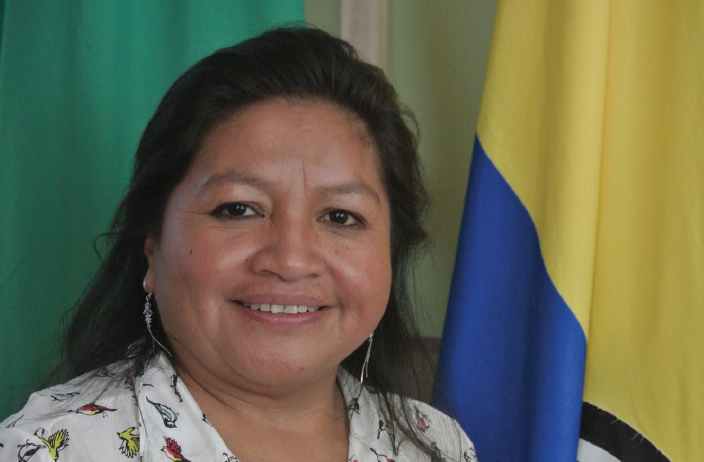
A commercial agreement for fruit farmers and institutional strengthening interventions have allowed indigenous Nasa leaders in the municipal government to improve delivery on rural development initiatives while building trust among citizens.
Every day, as Mayor Flor Ilva Trochez walks to her office, she passes the portrait of one of the most important heroes of the Nasa indigenous community in the municipality of Jambaló. Marden Betancur Conda was halfway through his four-year mandate when he was gunned down in 1996 by a leftist guerrilla group. The community’s first indigenous mayor had been pushing forth Jambaló’s Municipal Development Plan, which set out to strengthen indigenous land rights and give the community a larger say in local government.
Jambaló is unlike other Colombian municipalities: its population is nearly 100 percent indigenous, and for the past 25 years, political leadership has been intertwined with Nasa tribal leadership.
“Our most important weapon is community mobilization. After our mayor was assassinated, we never stopped carrying out development plans,” explains Trochez, Colombia’s first indigenous woman to become mayor.
Today, Trochez—who stepped into her role in January 2016—is building on nearly 30 years of Nasa collective memory to bring better infrastructure, agricultural projects, and culture and identity to the more than 17,000 people living in Jambaló. As she sees it, thanks to the ongoing peace process, Jambaló finally has the opportunity to improve the lives of its residents without fear of reprisal from the guerrilla and paramilitary groups that once patrolled the region’s hinterlands.
“After our mayor was assassinated, there was a 15-year period in which Jambaló was stagnant. We received no visitors. We were disconnected,” explains Trochez. “The conflict got deeper and deeper into our society. Children were recruited, and people were disappearing.”
Today, the community’s overall objectives remain unchanged: unite Nasa tribal lands and ensure the people living on them are at the forefront of shaping the community’s future. To do this, community mobilization is critical. And nothing better reflects the community’s priorities than the Municipal Development Plan. Every four years, the mayor and her staff work with the community to revise the plan, which always reflects a broader 20-year indigenous “Life Plan” that spells out the community’s values and overall development vision.
The problem is that without technical expertise in development planning, the municipal government has seen its work double in size every four years as unfinished tasks accumulate from previous administrations.
In 2016, the USAID-funded Land and Rural Development Program began partnering with Trochez and her administration to restructure the Municipal Development Plan and carve out realistic goals based on the administration’s capacity. An important aspect of those goals include connecting Jambaló’s farmers to new markets.
In February 2017, the program facilitated a commercial agreement between Jambaló fruit farmers and Colombian firm Comfandi to market highland fruit. Under the agreement, the commercial partner guarantees the purchase of one metric ton of lulo fruit every two weeks while guaranteeing the same price one month at a time. In return for a steady supply of quality fruit, the company will increase the purchasing price by an average of 30%, from US$700 to US$900 per ton.
In addition, USAID and the municipality worked together to create the municipality’s Agricultural Development Plan, which outlines products and value chains in need of investment and technical assistance. Trochez and her team have earmarked US$300,000 for agriculture development over the next four years and are putting a weighty focus on the production of coffee, fruits, and a multipurpose agave fiber known as fique.
As part of USAID’s institutional strengthening package, the program also trained municipal leaders to formulate projects that embrace the same principles and characteristics as those typically funded by the national government.
“Municipalities like Jambaló are now ready to start mobilizing resources from the national government. For example, when the Ministry of Agriculture issues requests for proposals, these municipalities already have a general plan outlining what kind of technical assistance they need, as well as a municipal-wide registry of farmers,” explains Cielo Ordoñez, the Land and Rural Development Program’s regional manager in Northern Cauca.
Under the new agricultural plan, USAID set up a producers’ forum to bring leaders together and help define the direction of Jambaló’s agricultural products. In late 2016, USAID sponsored an inter-regional exchange forum at an agribusiness vocational center in Risaralda, where farmers and municipal leaders acquired skills and knowledge for creating and managing successful agricultural associations.
“With these skills and knowledge, we can strengthen our associations,” explains Vicente Quimboa, Jambaló’s secretary of agriculture. “We know that we have to market our products and create a brand and put them out there in front of potential buyers and consumers.”
“Today, we have set annual goals for each of the next four years. By creating a realistic development plan, we also win credibility with our community and no longer suffer the anxiety of not being able to complete our plans.”
— Flor Ilva Trochez, Mayor of Jambaló and Colombia’s first indigenous female mayor

